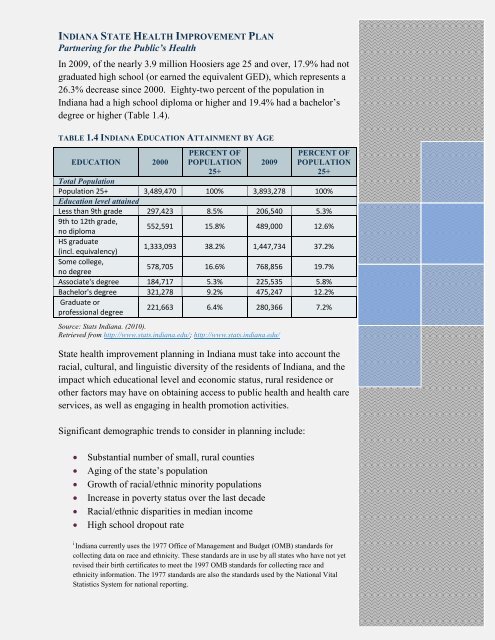Indiana State Health Improvement Plan (I-SHIP) - State of Indiana
Indiana State Health Improvement Plan (I-SHIP) - State of Indiana
Indiana State Health Improvement Plan (I-SHIP) - State of Indiana
Create successful ePaper yourself
Turn your PDF publications into a flip-book with our unique Google optimized e-Paper software.
INDIANA STATE HEALTH IMPROVEMENT PLAN<br />
Partnering for the Public’s <strong>Health</strong><br />
In 2009, <strong>of</strong> the nearly 3.9 million Hoosiers age 25 and over, 17.9% had not<br />
graduated high school (or earned the equivalent GED), which represents a<br />
26.3% decrease since 2000. Eighty-two percent <strong>of</strong> the population in<br />
<strong>Indiana</strong> had a high school diploma or higher and 19.4% had a bachelor‘s<br />
degree or higher (Table 1.4).<br />
TABLE 1.4 INDIANA EDUCATION ATTAINMENT BY AGE<br />
EDUCATION 2000<br />
PERCENT OF<br />
POPULATION<br />
25+<br />
2009<br />
PERCENT OF<br />
POPULATION<br />
25+<br />
Total Population<br />
Population 25+ 3,489,470 100% 3,893,278 100%<br />
Education level attained<br />
Less than 9th grade 297,423 8.5% 206,540 5.3%<br />
9th to 12th grade,<br />
no diploma<br />
552,591 15.8% 489,000 12.6%<br />
HS graduate<br />
(incl. equivalency)<br />
1,333,093 38.2% 1,447,734 37.2%<br />
Some college,<br />
no degree<br />
578,705 16.6% 768,856 19.7%<br />
Associate's degree 184,717 5.3% 225,535 5.8%<br />
Bachelor's degree 321,278 9.2% 475,247 12.2%<br />
Graduate or<br />
pr<strong>of</strong>essional degree<br />
221,663 6.4% 280,366 7.2%<br />
Source: Stats <strong>Indiana</strong>. (2010).<br />
Retrieved from http://www.stats.indiana.edu/; http://www.stats.indiana.edu/<br />
<strong>State</strong> health improvement planning in <strong>Indiana</strong> must take into account the<br />
racial, cultural, and linguistic diversity <strong>of</strong> the residents <strong>of</strong> <strong>Indiana</strong>, and the<br />
impact which educational level and economic status, rural residence or<br />
other factors may have on obtaining access to public health and health care<br />
services, as well as engaging in health promotion activities.<br />
Significant demographic trends to consider in planning include:<br />
� Substantial number <strong>of</strong> small, rural counties<br />
� Aging <strong>of</strong> the state‘s population<br />
� Growth <strong>of</strong> racial/ethnic minority populations<br />
� Increase in poverty status over the last decade<br />
� Racial/ethnic disparities in median income<br />
� High school dropout rate<br />
i <strong>Indiana</strong> currently uses the 1977 Office <strong>of</strong> Management and Budget (OMB) standards for<br />
collecting data on race and ethnicity. These standards are in use by all states who have not yet<br />
revised their birth certificates to meet the 1997 OMB standards for collecting race and<br />
ethnicity information. The 1977 standards are also the standards used by the National Vital<br />
Statistics System for national reporting.

















